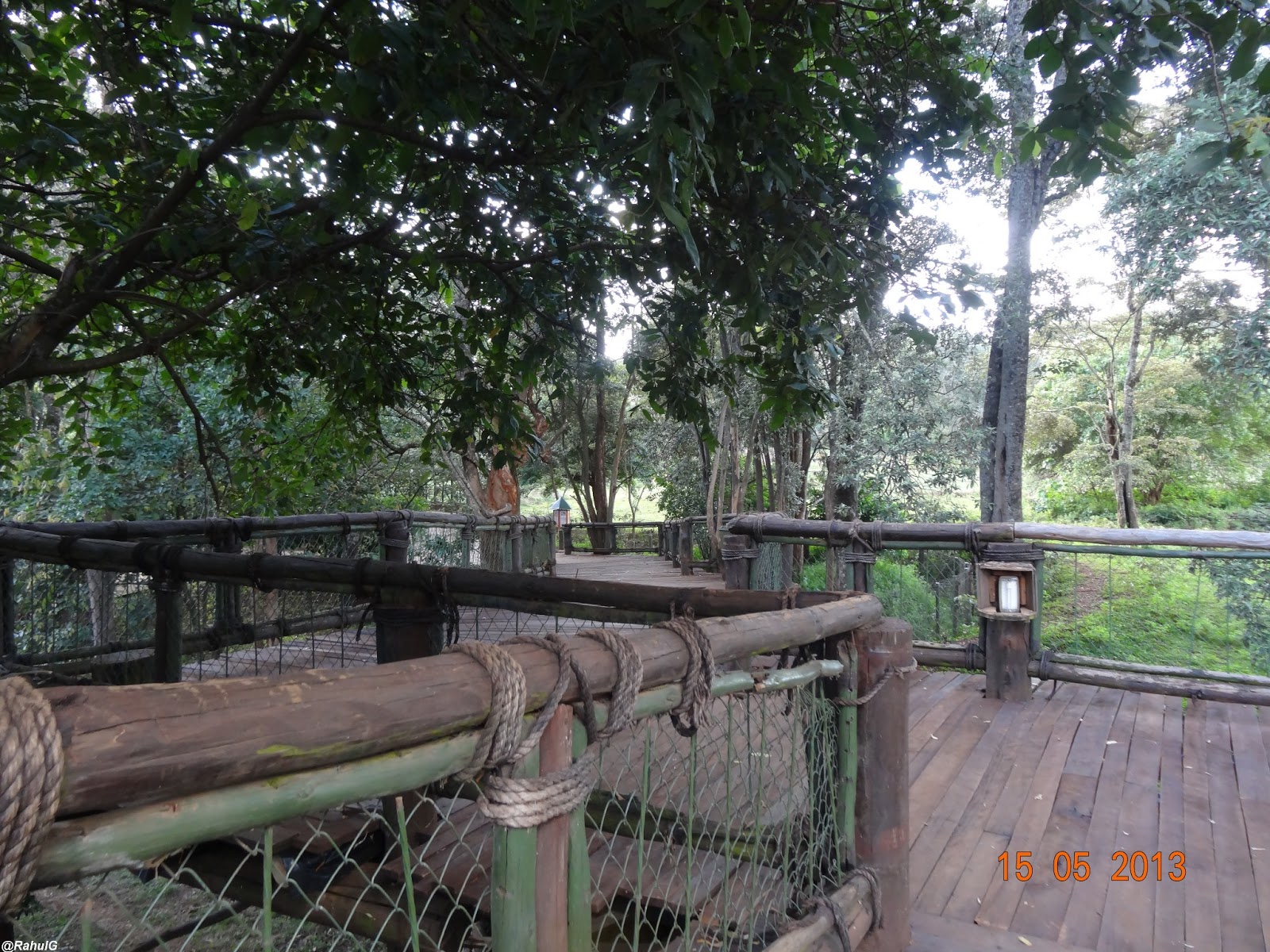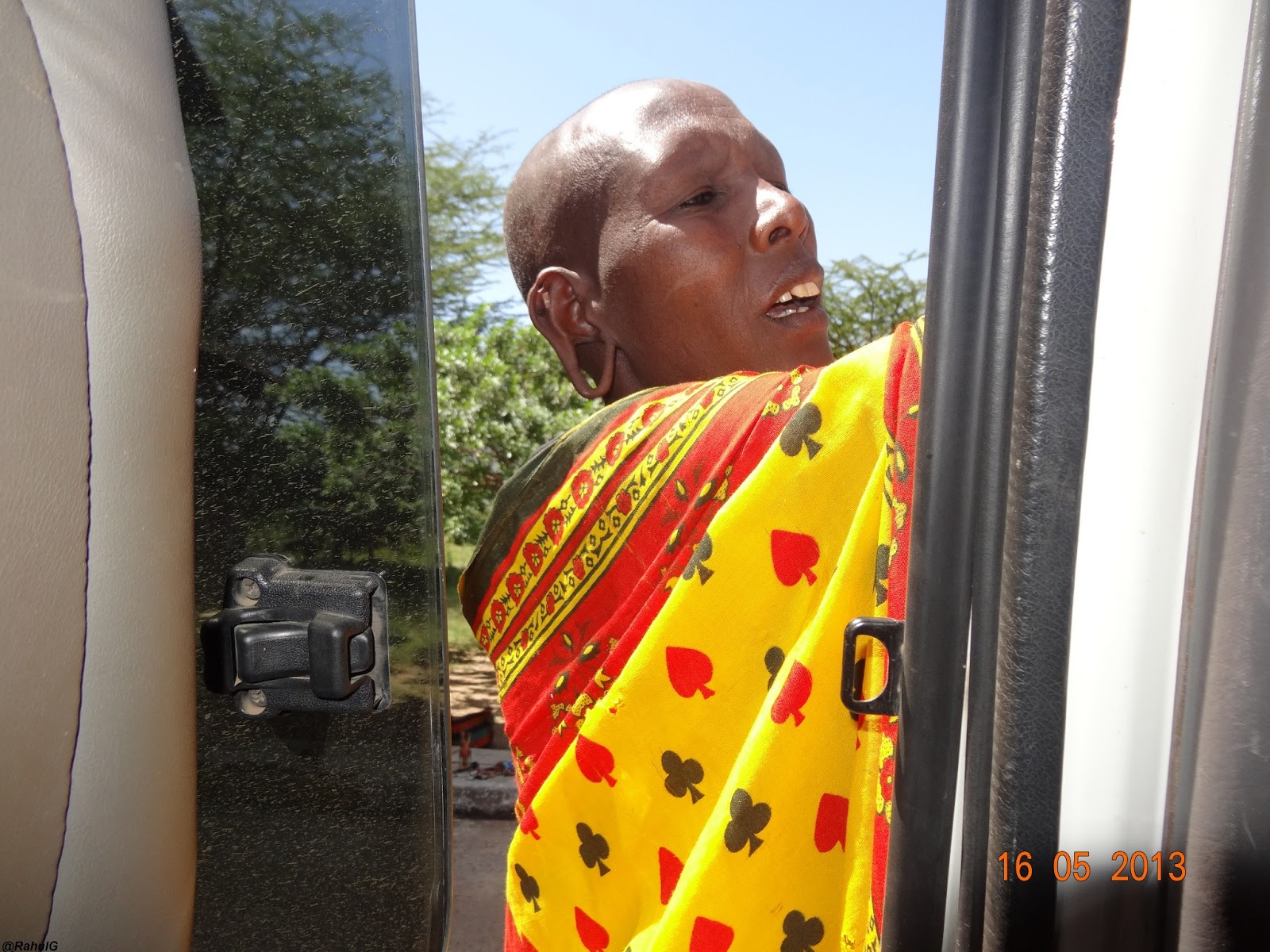This is the 2nd part of the 3-part travel diary "Big Five and the Burj Khalifa", featuring the wildlife in Kenya. You can read Part-1 here and Part-3 here.
Tamed in the city
Nairobi has some wildlife parks right in the city, possibly to prepare the uninitiated for the wonders that lay beyond. One such is the Nairobi Safari Walk & Animal Orphanage, which we visit on the last evening of our stay.
The place is steeply priced for us foreigners. But the thought of exorbitant admission charges for the foreigners at Tajmahal serves as a sobering context.
We are let in to an expansive, well-kept zoo, with winding wooden walkaways through the enclosures & cages.
Hyenas look at us across the fence with curiosity while the white rhino sleeps on, ignoring us completely.
The cheetah sleeps too far away in the bushes for us to see but there are gazelles, crocodiles, ostriches. wildebeests, birds. Many of these animals and birds are rescued from being orphaned, injured or extinct.
Having primed thus, we can not wait to be in the wild.
The Great Rift Valley & Nameless General Store
As we leave Nairobi for Masai Mara, the road winds down the mountains and before hitting the planes, we oversee the Great Rift Valley - a vast expanse of green lined by mountains.
The Great Rift valley is the name given to a geographical trench stretching a mind-boggling 9600kms from Israel to Mozambique, as Coke dutifully informs us. Look closely at the map in the photograph below and you can see it dropping down from Ethiopia and sliding down over the horn to reach Kenya and then Mozambique.
As I resolve to look up the details on the Wikipedia, I realise how the vastness of nature humbles us. I also suddenly recall the National Geographic gene mapping project, which has established Africa as the place from where the human species originated. I have a strange feeling of having established a lost connection with our collective past, a sort of completing the circle of life.... Why am I getting these goose-pimples?
When we hit the plains, the road is lined mostly with villages and some towns few and far in between. If the names are any indication, the villages are deeply religious - a large number of shops and small businesses along the highway are named after biblical virtues like Beauty, Grace, Joy, Honesty et al. I do actually see a lot of churches (and an odd temple too).
There is one shop despairingly named as "Nameless General Store". What is this about, I wonder - atheism or plain laziness?
Lions and Warriors
Masai Mara, the world famous game reserve, home to the Big Five, carries its world-wide reputation lightly.
As we turn south-west from the town of Narok after around 3 hours drive from Nairobi, the road turns to gravel, and then disappears altogether. After a while, we are driving through a jungle of mostly grass, short trees, intercepted by small streams and brooks. It is slightly hot (the vehicles have no air-conditioning) and in between the trees, we catch a flash of red, which turns out to be a cowherd draped in a bright red chequered shawl.
Slowly, the big trees give way to a land clearing leading to a big gate. At one side is a group of women draped in bright colours, who run towards us with their wares. Beyond the gate we get a glimpse of a zebra, which is grazing next to buffalo skulls lined up like trophies. We have arrived at Masai Mara Game Reserve.
Masai Mara takes its name from "Masai" - the ancient hunter tribe which inhabits this area. They are fierce, nomadic warriors and it is said that lions do not attack Masai people.
"Mara" means "mottled" or "spotted" and refers to vegetation pattern of the area.
Big Five is part of an hunters' lexicon of the yore, referring to the five most fierce and dangerous animals to hunt - the Lion, African Elephant, Buffalo, Rhinoceros and Leopard.
The game reserve itself is a vast undulating grassland - an expanse of green merging in the horizon with the azure blue of the skies or the dark green of the mountains.
Perched inside our safari vehicles, it seems we are in the midst of an animation movie, with all the animals lined up on a single wide canvas.
There is a herd of wildebeests munching on one side.
On the other side are zebras, with their stripes looking almost hand-painted, with a backdrop of gazelles.
We stop to let a tower (yes, that's what a group is called) of giraffes pass; watching giraffes walk is a surreal sight, like these tall animals are moonwalking.
Buffaloes hold their famous "whatsup" stare with us, while elephants are not concerned.
We furiously click our cameras, wishing to capture the spirit of what our naked eyes see and our hearts feel, unsuccessfully. In the two safaris we take while in Masai Mara, there are a lot of animals and birds we get a chance to watch in their natural habitat.
But the stars of the show are indisputably the lions. The moment the wireless radios crackle with the news of a lion sighting, all other animals are promptly forgotten and all vehicles converge upon the spot to make the most of the moment.
A lion truly is a magnificent animal and as we watch, holding our breath, we come to realise what does it mean being in a royal attendance.
In our safari the next morning, we meet the family.
Next - Dubai
Previous - Nairobi
Tamed in the city
Nairobi has some wildlife parks right in the city, possibly to prepare the uninitiated for the wonders that lay beyond. One such is the Nairobi Safari Walk & Animal Orphanage, which we visit on the last evening of our stay.
The place is steeply priced for us foreigners. But the thought of exorbitant admission charges for the foreigners at Tajmahal serves as a sobering context.
We are let in to an expansive, well-kept zoo, with winding wooden walkaways through the enclosures & cages.
 |
| The Wooden Walkaway |
 |
| The Curious Hyena |
 |
| The Sleeping White Rhino |
The albino zebras munch on nonchalantly, as do the giraffes.
 |
| Albino Zebras |
 |
| Giraffe, of course! |
Lions talk to us through the glass partition, while the Colobus monkeys chatter incoherently.
 |
| Keshav & the Lioness in intense dialogue |
 |
| Colobus Monkey |
Having primed thus, we can not wait to be in the wild.
The Great Rift Valley & Nameless General Store
As we leave Nairobi for Masai Mara, the road winds down the mountains and before hitting the planes, we oversee the Great Rift Valley - a vast expanse of green lined by mountains.
 |
| The Great Rift Valley |
As I resolve to look up the details on the Wikipedia, I realise how the vastness of nature humbles us. I also suddenly recall the National Geographic gene mapping project, which has established Africa as the place from where the human species originated. I have a strange feeling of having established a lost connection with our collective past, a sort of completing the circle of life.... Why am I getting these goose-pimples?
When we hit the plains, the road is lined mostly with villages and some towns few and far in between. If the names are any indication, the villages are deeply religious - a large number of shops and small businesses along the highway are named after biblical virtues like Beauty, Grace, Joy, Honesty et al. I do actually see a lot of churches (and an odd temple too).
There is one shop despairingly named as "Nameless General Store". What is this about, I wonder - atheism or plain laziness?
Lions and Warriors
Masai Mara, the world famous game reserve, home to the Big Five, carries its world-wide reputation lightly.
As we turn south-west from the town of Narok after around 3 hours drive from Nairobi, the road turns to gravel, and then disappears altogether. After a while, we are driving through a jungle of mostly grass, short trees, intercepted by small streams and brooks. It is slightly hot (the vehicles have no air-conditioning) and in between the trees, we catch a flash of red, which turns out to be a cowherd draped in a bright red chequered shawl.
 |
| The Masai Cowherd in Signature Red of the Masai Tribe |
Masai Mara takes its name from "Masai" - the ancient hunter tribe which inhabits this area. They are fierce, nomadic warriors and it is said that lions do not attack Masai people.
"Mara" means "mottled" or "spotted" and refers to vegetation pattern of the area.
Big Five is part of an hunters' lexicon of the yore, referring to the five most fierce and dangerous animals to hunt - the Lion, African Elephant, Buffalo, Rhinoceros and Leopard.
The game reserve itself is a vast undulating grassland - an expanse of green merging in the horizon with the azure blue of the skies or the dark green of the mountains.
Perched inside our safari vehicles, it seems we are in the midst of an animation movie, with all the animals lined up on a single wide canvas.
There is a herd of wildebeests munching on one side.
On the other side are zebras, with their stripes looking almost hand-painted, with a backdrop of gazelles.
We stop to let a tower (yes, that's what a group is called) of giraffes pass; watching giraffes walk is a surreal sight, like these tall animals are moonwalking.
Buffaloes hold their famous "whatsup" stare with us, while elephants are not concerned.
We furiously click our cameras, wishing to capture the spirit of what our naked eyes see and our hearts feel, unsuccessfully. In the two safaris we take while in Masai Mara, there are a lot of animals and birds we get a chance to watch in their natural habitat.
But the stars of the show are indisputably the lions. The moment the wireless radios crackle with the news of a lion sighting, all other animals are promptly forgotten and all vehicles converge upon the spot to make the most of the moment.
A lion truly is a magnificent animal and as we watch, holding our breath, we come to realise what does it mean being in a royal attendance.
 |
| His Highness |
 |
| The Morning Scent |
| |
In the night, at our lodge in the midst of the jungle, we are invited to watch the feeding of wild animals. As the attendant puts raw meat in the centre of the clearing, we see a hyena, a jackal and cats standing, poised to fight each other for the biggest share. As he withdraws, the matter is sorted out in minutes, and there remains an eerie silence on the scene.
Masai Mara is nature at its serene best, largely unsullied by us human beings. Animals proudly and justifiably own the space, graciously allowing us to have a peep in to their world. As we leave, we carry a lot of memories of this world in photographs, and a lot more in our minds.
Next - Dubai
Previous - Nairobi










1 comment:
I had seen a documentary on masaimara on geo net long ago.since then.I had a desire to see and learn about masai.this trip of yours had served a platter of stories and pics to me and my satiety has started craving for more.
It was a treat indeed.thanks...
And above all I believe u have percolated those gooses down to us.
Post a Comment